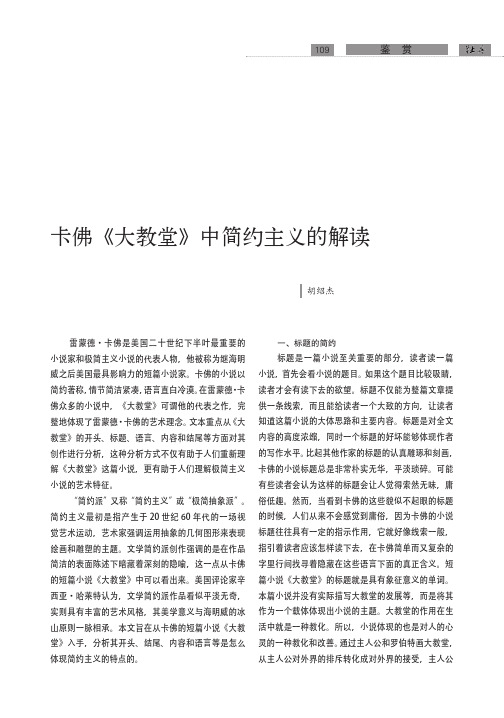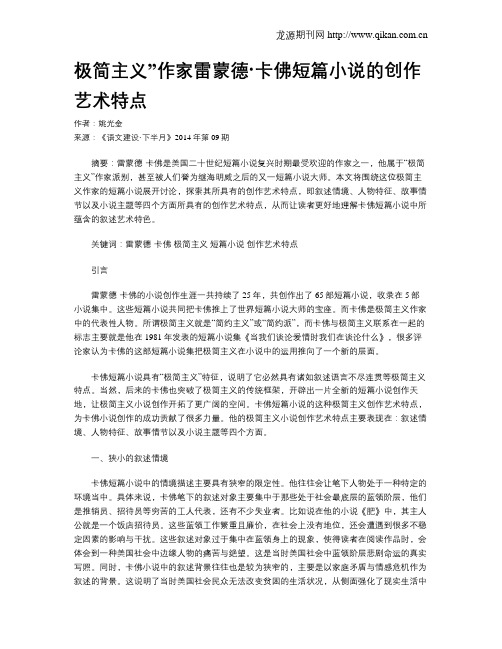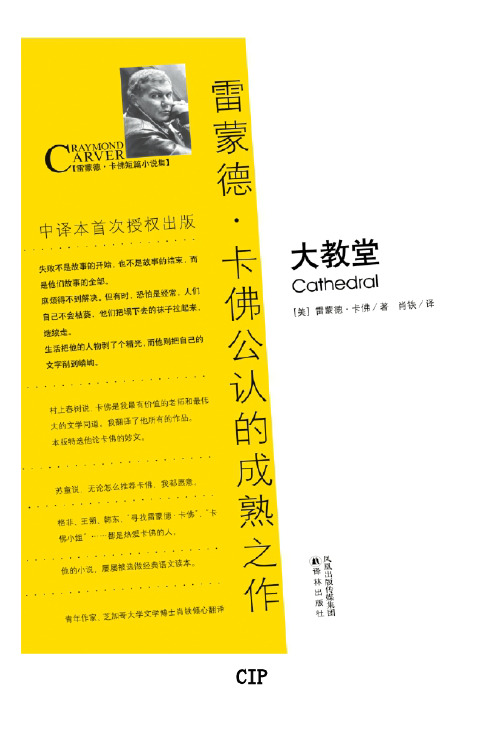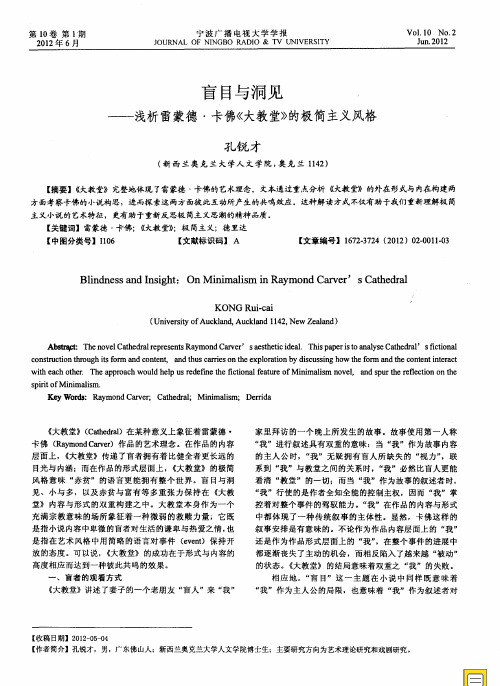_极简主义_中的人文关怀_评雷蒙德_卡佛短篇小说集_大教堂_
- 格式:pdf
- 大小:407.67 KB
- 文档页数:3

卡佛《大教堂》中简约主义的解读胡绍杰雷蒙德·卡佛是美国二十世纪下半叶最重要的小说家和极简主义小说的代表人物,他被称为继海明威之后美国最具影响力的短篇小说家。
卡佛的小说以简约著称,情节简洁紧凑,语言直白冷漠。
在雷蒙德·卡佛众多的小说中,《大教堂》可谓他的代表之作,完整地体现了雷蒙德·卡佛的艺术理念。
文本重点从《大教堂》的开头、标题、语言、内容和结尾等方面对其创作进行分析,这种分析方式不仅有助于人们重新理解《大教堂》这篇小说,更有助于人们理解极简主义小说的艺术特征。
“简约派”又称“简约主义”或“极简抽象派”。
简约主义最初是指产生于20世纪60年代的一场视觉艺术运动,艺术家强调运用抽象的几何图形来表现绘画和雕塑的主题。
文学简约派创作强调的是在作品简洁的表面陈述下暗藏着深刻的隐喻,这一点从卡佛的短篇小说《大教堂》中可以看出来。
美国评论家辛西亚·哈莱特认为,文学简约派作品看似平淡无奇,实则具有丰富的艺术风格,其美学意义与海明威的冰山原则一脉相承。
本文旨在从卡佛的短篇小说《大教堂》入手,分析其开头、结尾、内容和语言等是怎么体现简约主义的特点的。
一、标题的简约标题是一篇小说至关重要的部分,读者读一篇小说,首先会看小说的题目。
如果这个题目比较吸睛,读者才会有读下去的欲望。
标题不仅能为整篇文章提供一条线索,而且能给读者一个大致的方向,让读者知道这篇小说的大体思路和主要内容。
标题是对全文内容的高度浓缩,同时一个标题的好坏能够体现作者的写作水平。
比起其他作家的标题的认真雕琢和刻画,卡佛的小说标题总是非常朴实无华,平淡琐碎。
可能有些读者会认为这样的标题会让人觉得索然无味,庸俗低趣。
然而,当看到卡佛的这些貌似不起眼的标题的时候,人们从来不会感觉到庸俗,因为卡佛的小说标题往往具有一定的指示作用,它就好像线索一般,指引着读者应该怎样读下去,在卡佛简单而又复杂的字里行间找寻着隐藏在这些语言下面的真正含义。

豆瓣8.9《大教堂》|卡佛笔下的极简主义、现实困境与意象运用在朋友的推荐之下,我拜读了雷蒙德.卡佛的短篇小说《大教堂》。
在没阅读之前,我对卡佛的有关资料一无所知。
趁着这次阅读的机会,我才有幸得知在美国二十世纪下半叶,有着这样一位极简主义的代表。
他被誉为继海明威之后最具影响力的美国作家,行文简练,在修辞手法的运用方面吝啬无比。
因为描写的是美国蓝领阶层的真实现状,所以在当时经常遭受美国梦鼓吹者的抵制。
但无论世人怎样看待,这位其貌不扬的短篇小说大家在他的创作生涯中始终保持着自己的特色。
1983年,《大教堂》短篇小说集问世,成为了他创作的巅峰。
《大教堂》中的短篇小说依旧淋漓尽致地体现着他简约的写法,依旧不厌其烦地描写着美国底层群众的现实困顿。
今天,我将以与这部短篇小说合集同名的短篇小说《大教堂》为例,解读卡佛笔下的极简主义,现实困境,并分析他在文中对意象的运用。
1、相较于之前来说的慷慨,难逃的极简主义尽管卡佛本人被誉为美国极简主义大师,但他本人却相当抵触这一说法。
1983年《大教堂》发表之后,不少文学评论家都在此中看见了卡佛本人对于突破极简风格的努力。
他在《大教堂》中的描写,难得地被人用“慷慨”二字来形容,但无论如何,这部短篇小说从头到尾都依旧充斥着卡佛的极简笔法。
①选材的简单,意蕴的丰富《大教堂》讲述了主人公“我”的妻子邀请认识长达十多年的盲人朋友来家中作客,我与盲人在看电视的过程中恰好碰上电视解说员在介绍各国的大教堂,于是盲人拜托“我”为他介绍大教堂具体样貌的故事。
无论从哪个角度去看,全文描写的无非就是日常生活的琐事,用一句话总结即为“妻子的盲人朋友到我家做客的经历”。
这样的描写内容符合卡佛一贯的调性,他十分擅长把美国蓝领阶层的生活摆到明面上,用笔记录这些看似无足轻重的琐碎日常。
但他简单的选材背后却波涛汹涌,直击底层人物生活的矛盾。
他揭露的矛盾,是底层群众在精神上的自我隔离。
《大教堂》中的妻子与前夫虽是青梅竹马,却仍然感觉在灵魂上没有共同语言,于是她最终服药,试图自杀,离婚后嫁给了“我”。

极简主义”作家雷蒙德·卡佛短篇小说的创作艺术特点作者:姚光金来源:《语文建设·下半月》2014年第09期摘要:雷蒙德·卡佛是美国二十世纪短篇小说复兴时期最受欢迎的作家之一,他属于“极简主义”作家派别,甚至被人们誉为继海明威之后的又一短篇小说大师。
本文将围绕这位极简主义作家的短篇小说展开讨论,探索其所具有的创作艺术特点,即叙述情境、人物特征、故事情节以及小说主题等四个方面所具有的创作艺术特点,从而让读者更好地理解卡佛短篇小说中所蕴含的叙述艺术特色。
关键词:雷蒙德·卡佛极简主义短篇小说创作艺术特点引言雷蒙德·卡佛的小说创作生涯一共持续了25年,共创作出了65部短篇小说,收录在5部小说集中。
这些短篇小说共同把卡佛推上了世界短篇小说大师的宝座。
而卡佛是极简主义作家中的代表性人物。
所谓极简主义就是“简约主义”或“简约派”,而卡佛与极简主义联系在一起的标志主要就是他在1981年发表的短篇小说集《当我们谈论爱情时我们在谈论什么》,很多评论家认为卡佛的这部短篇小说集把极简主义在小说中的运用推向了一个新的层面。
卡佛短篇小说具有“极简主义”特征,说明了它必然具有诸如叙述语言不尽连贯等极简主义特点。
当然,后来的卡佛也突破了极简主义的传统框架,开辟出一片全新的短篇小说创作天地,让极简主义小说创作开拓了更广阔的空间。
卡佛短篇小说的这种极简主义创作艺术特点,为卡佛小说创作的成功贡献了很多力量。
他的极简主义小说创作艺术特点主要表现在:叙述情境、人物特征、故事情节以及小说主题等四个方面。
一、狭小的叙述情境卡佛短篇小说中的情境描述主要具有狭窄的限定性。
他往往会让笔下人物处于一种特定的环境当中。
具体来说,卡佛笔下的叙述对象主要集中于那些处于社会最底层的蓝领阶层,他们是推销员、招待员等穷苦的工人代表,还有不少失业者。
比如说在他的小说《肥》中,其主人公就是一个饭店招待员。
这些蓝领工作繁重且廉价,在社会上没有地位,还会遭遇到很多不稳定因素的影响与干扰。

摘要世纪是位美国短篇说家和诗人,在20七八蒙·卡佛(1938-1988)一小雷德年代他五部短篇说集为美国短篇说的复兴做出极贡献教堂》十,小小大。
《大的年为其第部短篇集侧映主公们情精说重反人感焦虑和神交流(1983)三小,,极平静,着与其它作相比品,少了些阴郁和束缚。
此外,《大教堂》以为的笔触描写他们的家庭困境和的挣扎,对内反映出卡佛战眼根阶层的日常生活,心于草后美国社会中困惑的人们的关注因为卡佛是这迷茫们中员些的人的,也一。
兰克和·米克约瑟·弗戴维篇论合·佐兰的空模型间,夫本文旨在结加百利从教堂中尔的空间亨·斐三列伏尔的空间元性等理论,《大》本森文思想以及利选出五个事论个层次的空间建构,以阐明《大教堂》如何呈现主角反复出故讨三好事》中的文保》,《小心》和《一小件章研第究《鲜现的焦虑感。
首先,二了作或相同,非性情节中建在线故事在这个故事中,者使用重复的意象空。
三本间章火包厢》第论《车立的焦虑感,以达到连贯和强调的目的。
其次,三讨了起统一而火包厢是外部世界和主角之间的隐喻界,大和《大教堂》内的地志空间。
车边神与焦虑交。
疏离、精交流的顿悟交了本则超它的文,成为流的象征教堂越存在第四章从社会空间的角度考察之地志在。
最后,了织在起,一使与结构联系起一火包厢》、《鲜保》、《小心》、《发烧》和《大教堂》中主角与同伴的几《车他们的以及内离异妻关系和陌生关系),心种关系(父子关系,夫妻关系,夫人焦虑。
感读者呈工和活中为现日常作生直,了本论文的论是结:卡佛用朴素白的语言从根上说,小焦。
本卡佛在短篇说中刻画从主人公直面现代生活的暗潮涌的虑汹启者思残酷和人生的孤独,呼同时邀请读者聆听主他们绝望和焦虑的唤,发读考该如何到拯救自己自己内的教堂,找心大。
佛教堂间根层焦卡虚构空草阶虑关词:键雷蒙德·,《大》,,,CONTENTS ACKNOWLEDGEMENTS (ii)ABSTRACT (iii)摘要 (v)CONTENTS (vi)CHAPTER ONE INTRODUCTION (1)1.1A Brief Introduction to Raymond Carver and Cathedral (1)1.2A Review of Relevant Literature (2)1.3Thesis Statement and Research Questions (4)1.4Related Theories (5)1.4.1Three Levels of Structuring Space by Gabriel Zoran (5)1.4.2Joseph Frank and David Mickelsen’s Ideas of Textual Space (6)1.4.3Social Space:Henri Lefebvre’s Spatial Triad (7)1.4.4Anxiety (8)1.5Significance of the research (9)1.6Analysis Procedure (10)CHAPTER TWO ANXIETY OVER LOSING CONTROL:ANALYSIS OF TEXTUAL SPACE (11)2.1Repetition:Image of Failure in“Careful” (11)2.2Repetition:Image of Stasis in“Preservation” (14)2.3Juxtaposition of Present and Past:Image of Personal Plight (16)2.4Summary (18)CHAPTER THREE ANXIETY OVER THE UNKNOWN:ANALYSIS OF TOPOGRAPHICAL SPACE (20)3.1“The Compartment”:The Wall and Isolation (20)3.2“Cathedral”:The Home and Spiritual Cathedral (23)3.3Summary (26)CHAPTER FOUR STRANDED SOCIAL INTERCOURSE:ANALYSIS OF SOCIAL SPACE (27)4.1Distracted Father-son Relationship in“The Compartment” (27)4.2Marital Dilemma in“Preservation”and“Careful” (29)4.3Separated Husband in“Fever” (32)4.4An Anxious Host in“Cathedral” (35)4.5Summary (37)CHAPTER FIVE CONCLUSION (39)WORKS CITED (44)CHAPTER ONE INTRODUCTION1.1A Brief Introduction to Raymond Carver and CathedralRaymond Carver(1938—1988),in full Raymond Clevie Carver,is an American short-story writer and poet whose realistic writings about the working poor mirrored his own life.Carver was the son of a sawmill worker.He married a year after finishing high school and supported his wife and two children by working as a janitor,gas-station attendant,and delivery man.He became seriously interested in a writing career after taking a creative-writing course at Chico State College (now California State University,Chico)in1958.In spite of average classroom execution from grade school through college,Carver acquired an unquenchable and deep-rooted reading addiction.Reading was one approach to escape the capriciousness of life with a debilitated,alcoholic father and a supportive mother,an example Carver would copy in his own marriage(Chad457).Carver initially declared his intent of becoming a playwright as a teenager,whilst on a chasing trek with a family companion,and he followed through on his statement.Registering in the Palmer Scheme,a mail-order composition program,Raymond finished the course prerequisites in a way that proposed his jaded school execution was the consequence of weariness as opposed to feeble aptitude.His short stories began to appear in magazines while he studied at Humboldt State College(now Humboldt State University)in Arcata,California(B.A.,1963).Carver’s first success as a writer came in1967with the story“Will You Please Be Quiet,Please?”and he began writing full-time after losing his job as a textbook editor in1970.The highly successful short-story collection Will You Please Be Quiet,Please?(1976)established his reputation.Carver began drinking heavily in1967and was repeatedly hospitalized for alcoholism in the1970s,while continuing to produce short stories.After surmounting his drinking problem in the late1970s,he taught for several years at the University of Texas at El Paso and at Syracuse University,and in1983he won a literary award whose generous annual stipend freed him to again concentrate on his writing full-time.His later short-story collections were What We Talk About When We Talk About Love(1981),Cathedral(1984),and Where I’m Calling From(1988). While his short stories were what made his critical reputation,he was also anaccomplished poet in the realist tradition of Robert Frost.Carver’s poetry collections include At Night the Salmon Move(1976),Where Water Comes Together with Other Water(1985),and Ultramarine(1986).In the short stories Carver chronicled the everyday lives and problems of the working poor in the Pacific Northwest.His blue-collar characters are crushed by broken marriages,financial problems,and failed careers,but they are often unable to understand or even articulate their own anguish.Cathedral(1984),without exception,inherits Carver’s aforementioned tradition of,in account of trivial everyday life,giving voice to those ordinary people with whom Carver have“worked with and earned my living beside,for years”(qtd.in Mccaffery242).For instance,the divorced old couple who try so hard to revel in the old-time memory of living together in“Chef’s House”,the unemployed husband who has been a couch potato for months in“Preservation”,etc.The language in these twelve short stories hold the pared-down quality with straightforward description of the plot,which renders readers a sense of isolation and frustration.They can, meanwhile,play a crucial role in presenting Carver’s inner struggle as well as the anxious atmosphere in real American society in1980s.1.2A Review of Relevant LiteratureMultitudinous studies have been done on Raymond Carver and his works since the publication of Will You Please Be Quiet,Please?in1983.Researchers abroad have concentrated on masculinity or the epiphanic awakening in Carver’s“Cathedral”and“A Small Good Thing”,while most of the Chinese scholars have focused on the narrative strategies and thematic analysis from different perspectives.Criticisms AbroadDifferent stories in Cathedral have been examined over the past few decades. Chris Bullock(1994)analyzes how Carver portrays“the masculine ego through the metaphor of architecture”in one of Carver’s most acclaimed short stories,“Cathedral”.He claimed that a glimpse of masculinity could be seen by moving toward the unconscious,the recognition of death,empathy with others, acknowledgement of the value of the dimension of spirit,and acceptance of the aid of the feminine.Vanessa Hall(2009)supports his claim in The Journal of Men’s Studies by stating that Carver’s stories portray a more hopeful,constructive version ofmasculinity at odds with the traditional or hopelessly embattled versions of masculinity still dominating representations of masculinity in American culture. Laurie Champion(1997)chooses to unveil the silence in“Feathers”in an attempt to interpret the perplexed ending of the story.In his seminar paper,Andreas Wirag (2008)analyzes the other two stories“A Small,Good Thing”and“Cathedral”by applying fairly identical patterns to depict the characters“Bud”and“The Baker”and their development.He concludes that not only the individual character’s design is remarkably similar,but also the preconditions for change,the process of development itself and the result of the particular conversion they undergo.William Young(2017)asserts that the title story“Cathedral”reflects the possibility for connection and of transcendence.He concludes his article by acknowledging that the ending of“Cathedral”transforms the domestic space in the text and reaches the frontier landscape.Similarly,Polly Rose Peterson(2012)also subscribes to this argument and concedes that situating readers in a close relationship with the narrator and forcing them to view the world from the narrator’s perspective render readers a series of epiphanies,effectively conveying the story’s central message on‘blindness’and spiritual awakening(167).As is mentioned above,the scholarly criticism abroad flourish in the interpretation of one single story or several stories.However,no publication has been done to provide a more comprehensive outlook of Cathedral,which is cardinal in terms of the anatomy of Carver’s idiosyncrasy.Criticisms in ChinaDifferent perspectives have been utilized to analyze Raymond Carver’s Cathedral in China.Qiu Xiaoqing(2001)discusses in her article Carver’s view of fiction and the symbolism in Cathedral.In Raymond Carver’s Short Fiction in the History of Black Humor(2006),Zhou Jingqiong analyzes Carver’s black humor and the psycho-social implications of his short fiction and discovers the complexity with which simple words function;she also contextualizes the thematic and stylistic common ground for modernist,postmodernist,and neo-realist fiction in her paper “Raymond Carver’s Short Fiction vs.Black Humor”(2017),to focus on Carver’sBlack humor.Tang Weisheng(2011)examines the open-ending of Carver’s stories and finds out the open-endednesss is also a matter of historical choice.Li Xing(2014) interprets Cathedral with Foucault’s power-discourse theory and contends that the working-class characters of Cathedral,whom Raymond Carver dares to speak up for, are under the ubiquitous power environment.Deng Qianqian(2017),on the other hand,grasps the implied reader in Cathedral with the help of Wolfgang Iser’s Reader-response theory in order to show that Cathedral is one of the representative masterpieces of Raymond Carver’s dirty realist style.As to the narrative strategy,Lin Qiao(2018)applies the dream narrative to reveal the social dilemma faced by contemporary Americans.Researchers both abroad and at home focus on masculinity,thematic studies and narrative strategies.Insightful and thought-provoking as their studies are,some points are still missed by those researchers.Although“Cathedral”and“A Small Good Thing”have been thoroughly examined,other stories in Cathedral deserve the same amount of scholarly attention.What is more,the spatiality manifested in Cathedral and its relationship with anxiety have not been touched upon.In other words,based on the literature review at home and abroad,this thesis has found no systematic interpretation of Cathedral from the perspective of space theory.Furthermore,it is this recurring sense of anxiety taking on multifaceted forms in the stories that makes Cathedral thematically unified and distinctive.Some critics notice this component yet does not elaborate on it.Therefore,the study of three levels of structuring space and this recurring sense of anxiety and is of significance.1.3Thesis Statement and Research QuestionsThis thesis aims at discussing three levels of structuring space in seven selected stories from Cathedral(1983)in order to illustrate how the recurring sentiment expressed by Carver’s characters-the sense of anxiety,is portrayed.With the assistance of Gabriel Zoran’s model of space theory,Joseph Frank and David Mickelsen’s ideas of textual space as well as Henri Lefebvre’s spatial triad in social space,the thesis is to elaborate on this feature within the topographical level,thetextual level and social level,thus revealing the relationship between the fictional space and the sentiment.Research QuestionsThe research questions are as follows:1.How is the recurring sense of anxiety portrayed in Carver’s stories?2.What is the relationship between the fictional space and this sentiment?1.4Related Theories1.4.1Three Levels of Structuring Space by Gabriel ZoranSince the spatial turn in the late20th century on literary criticism,valuable works about the function of space have been produced.Lefebvre’s The Production of Space (1991)and Gaston Bachelard’s The Poetics of Space(1994)have exerted significant influence on the development of space theories.In the field of narratology,Seymour Chatman discriminated between story-space and discourse-space in his Story and Discourse(1978).Moreover,the role of space in narration is specially mentioned by Mieke Bal in Narratology(1978).Gabriel Zoran’s“Toward a Theory of Space in Narrative”(1984), however,provides perhaps the most valuable and practical model for the structuring of space within the narrative text.Zoran’s conception of space is based on the reconstructed world derived from language.In his opinion,the space in the narrative text could be divided into three levels,that is,the topographical space,the chronotopic space and the textual space.These three levels of space are the different levels of the reconstructed world and could not be separated.The topographical level:The word“topography”literally means the physical appearance of a particular area of land,especially the shape of its surface;however, the topographical level of structuring space,according to Zoran,is not limited to the direct description of some topographical structure.Instead,narrative,dialogue,or even essay can attribute to the reconstruction of the topographical structure as well (316),while in the meantime any specific movement or direction in the topographical structure is free of limitation.The chronotopic level:Originally taken by Russian scholar M.M.Bakhtin,the chronotope means how configurations of time and space are represented in language and discourse,including objects,events,psychology,history and so on. According to Zoran,however,the chronotope does not include the totality of time and space,but only signifies movement and actions of the narrative,encompassing synchronic relations(characters’motion/rest)and diachronic relations.At every synchronic situation,some objects move and others at rest(318).The textual level:Structuring space in the textual level means the organization of the reconstructed world,including the selectivity of language.What is more,Zoran proposes the concept of here-and-there point of view,but unable to further elaborate on these two terms.Therefore,this thesis will borrow the ideas of structuring textual space from Joseph Frank and David Mickelsen so as to complete a detailed and thorough investigation of Raymond Carver’s Cathedral.1.4.2Joseph Frank and David Mickelsen’s Ideas of Textual SpaceIn1945,Joseph Frank published the first version of his essay on spatial form in the Sewanee Review and compiled it later into a work called The Idea of Spatial Form(1991).Taking his cue from Sergei Eisenstein,Frank observes that the juxtaposition of disparate images in a cinematic montage automatically creates a synthesis of meaning between them,which supersedes any sense of temporal discontinuity.Frank builds his thesis further with Djuna Barnes’s Nightwood.Since the selection of details in Nightwood does not follow the logic of verisimilitude but is governed by a system of symbolic overtones that express the essence of a character in an image,he approaches the book spatially rather than temporally,and concludes that “these chapters are knit together,not by the progress of any action...but by the continual reference and cross-reference of images and symbols which must be referred to each other spatially throughout the time-act of reading”(34).Frank’s idea of spatial form inevitably strikes an immediate chord with David Mickelsen’s mechanisms of juxtaposition and repetition.In“Types of Spatial Structure in Narrative”(1981)Mickelsen points out that the reader perceives the continuing presentness of events through juxtaposition.What is more,the repetition or the same image for coherence and emphasis builds a sense of unity among thefragments while at the same time suggesting that time is not progressing or that it is going in circles.Because of this circularity,spatial-form narratives are only ended, not concluded,since possible increments are infinite(73).David Mickelsen’s argument also implies an understanding of non-linearity of existence.His idea of spatial structure acknowledges that the events in an organic conception of life are not so much recognizable as random and simultaneous(77).In his essay,he suggests that “spatial-form novels are not carrots,growing cumulatively and without interruption towards a climactic green effusion;rather they are oranges,with a number of similar segments,going nowhere or in circles focused on a single subject(the core)”(35).The assertion might be the best metaphor to describe what is a spatial story. Raymond Carver’s Cathedral and his previous collections of short stories are also structurally identical to orange,with no beginning nor denouement,many stories going nowhere or in circles,which this thesis will give much attention to exploring.To conclude,Gabriel Zoran,Joseph Frank and David Mickelsen have some common ground in terms of structuring textual space,the latter two more circumstantial in explaining what constitutes the textual space-discontinuity (juxtaposition)of present and past,repetition,recurrent image and so on.These strategies shatter the linear progression of a narrative,from which a multidimensional space structure is formed,hence the textual space.Therefore,to build a more clear framework when analyzing the textual level of structuring space,Joseph Frank and David Mickelsen’s ideas of textual space will also be employed.1.4.3Social Space:Henri Lefebvre’s Spatial TriadThe spatial triad is the gist of Lefebvre’s epoch-making publication The production of Space(1974).Introducing the concept of social space,he proposes three dimensions of(social)space:spatial practice(the perceived space),representations of space(the conceived space),and representational space(the lived space)(33).Spatial practice,or the perceived space,embodies daily reality and urban reality, such as work,private life and leisure(ibid.38).As an important element in shaping the spatial structure of people’s daily lives,spatial practice also means people’s behavior in space.Because people’s social life takes place in a certain space,people’s activities help shape the appearance of this space.In other words,human behaviorrender space special meanings,such as classrooms in class,parks in leisure,shopping malls,sports fields,etc.These different activities carried out by people not only enhance the value of space,but also form a specific appearance of the space.The representations of space,or the conceptualized space,is the spatial dimension of dominant status in any society(or mode of production).It is the space of architects,planners,urban scholars or engineers,who define what is lived and what is perceived with what is conceived(ibid.38).To put it succinctly,it involves the presentation of a given space,such as the appearance and meaning of the space per se, and the various ways we present it,such as models,words,images,concepts,and thinking.The representational space is the space of actual experience that truly belongs to the inhabitants and users.This space is dominated and passively experienced by those inhabitants and users;at the same time,it is fresh and present,and time is revealed in it(ibid.39).Between these two spaces,spatial practice is more like a tool/action/position,with which representations of space and representational space can be realized by itself in the perceived space.The thesis will only include the spatial practice and representational space when deciphering the anxiety from the social intercourse in the selected stories.1.4.4AnxietyTo unravel the anxiety experienced by Carver’s characters,This literary analysis should,first and foremost,sort out the concept of anxiety with the support of psychological expertise.Niraj Ahuja(2011)defines anxiety as“a‘normal’phenomenon,which is characterised by a state of apprehension or unease arising out of anticipation of danger(89).In his Psychological Approaches to Generalized Anxiety Disorder(2008), Holly Hazlett-Stevens states that people experience anxiety when facing impending threat(65).Anxiety often differs from fear,as fear is an apprehension in response to an external danger,while in anxiety the danger is largely unknown(or internal).”The content of worries,reported by individuals with general anxiety disorder(GAD),aresimilar to those reported by the rest of the population(Dugas&Robichaud,2007), including family,relationships,work,school,health,and finances,which is further cemented by Holly Hazlett-Stevens’s perspective of what constitutes anxiety,namely thoughts,physical sensations,subjective feelings and behaviors.Anxiety as human’s(or animal’s)evolved defense systems,according to theorists such as Gilbert(1993,1998)and Dixon(1998),are the common defensive options for responding to threats,encompassing escape,aggression,etc.The escape behavior,involving flight from the ongoing activities,is the most fundamental one (Dixon,421).The second defensive option is avoidance behavior that requires shunning away from the threats(H.Stevens18).Another defensive option,as Gilbert suggests,is aggressive behavior,including bullying,intimidation,or actual attack.As is stated before,the definition of anxiety is of great significance in terms of clarification for the thesis.However,the purpose of this thesis will,through textual analysis,centre on the manifestation of anxiety and how they are portrayed within three respective levels,as opposed to psychiatric diagnosis.1.5Significance of the researchAn American short-story writer and poet,Raymond Carver contributed to the revitalization of American short story during the1970s and1980s with his five major collections of short stories.His third significant collection of short stories Cathedral (1983),generally perceived as his best,includes the award-winning stories“A Small, Good Thing”and“Where I’m Calling From”.Carver’s oeuvre has been broadly studied by many scholars at home and abroad from different perspectives,but Some studies overemphasized the minimalist style in Carver’s stories.What is more,the collection Cathedral is overlooked,compared with the critical attention of his previous ones.Therefore,the significance of this thesis is to provide a different perspective in interpreting Cathedral for further understanding of Raymond Carver.In addition,in response to the spatial turn as a booming literary and cultural criticism,the present research emphasizes the importance of fictional space and its role on orchestratingatmosphere and emotions,thereby enriching the studies on American short stories.1.6Analysis ProcedureThis thesis aims at discussing three levels of structuring space in five selected stories from Cathedral(1989)in order to illustrate a recurring sense of anxiety that torture Carver’s characters.This thesis base the sequencing of the main chapters on the relativity with the reconstructed textual world.Chapter One provides the introduction of Raymond Carver and his Cathedral, literature review,and the related theories of space.Chapter Two will primarily dig up the textual space in“Preservation”and “Careful”for the purpose of demonstrating the characters’anxiety over losing control of their life,since the textual space is the most immediate one in terms of reconstruction.Chapter Three examines the topographical space in“The Compartment”and “Cathedral”in a bid to illustrate how the topographical elements render the atmosphere permeating anxiety,the anxiety over an unknown journey or a stranger.Chapter Four pecks apart the root of anxiety in different social intercourse from the perspective of social space,namely the father-son relationship in the story“The Compartment”,the marital relationship in“Preservation”and“Careful”,the broken relationship in“Fever”,and the unacquainted relationship in“Cathedral”.Although the thesis analyzes different stories in textual space,topographical space,and social space,every chapter is connected by a thread of a sentiment-anxiety.The revelation of the relationship between the fictional space and this specific sentiment will,therefore,be concluded in the last chapter.CHAPTER TWO ANXIETY OVER LOSING CONTROL:ANALYSIS OFTEXTUAL SPACE“The evidence is overwhelming…that men and women of today live in an‘age of anxiety.’If one penetrates below the surface of political,economic,business, professional,or domestic crises to discover their psychological causes,or if one seeks to understand modern art or poetry or philosophy or religion,one runs athwart the problem of anxiety at almost every turn.”—Rollo May(1950)Anxiety touches all our lives(Kessler,Walters,&Wittchen,2004).In recent years,anxiety disorders have become recognized as one of the most debilitating forms of mental illness in Western Society(Kessler,Mickelson,Barber,&Wang,2001; Rovner,1993)and affect as many as46million individuals in the United States alone (Kessler et al.,1994).Indeed,they are among the most common and prevalent types of psychological maladies in the United States(Shepherd,Cooper,Brown,&Kalton, 1996).Without exception,the fact that Carver himself has gone through such personal troubles as alcoholism and disease over the years contributes tremendously to the representation of anxiety in his fictional characters,as well as his empathy towards them.The aforementioned anxiety taking on multifaceted forms in the stories makes Cathedral(1984),as the following chapters aspires to explore,thematically unified and distinctive.2.1Repetition:Image of Failure in“Careful”Lloyd in“Careful”,an alcoholic man separated from his wife for two weeks, lives in a very small apartment,too small for him.One day his ear is plugged up and his wife comes for a visit.She wants to talk to him,but spends the whole time trying to solve his ear problem.His usual drunken life resumes after she leaves him without having talked to him.While the story is as much a character study as anything,it evokes Kafka’s“The Metamorphosis”(1915)in the way that it centers so strongly around a central metaphor:One morning,as Gregor Samsa was waking up from anxious dreams, he discovered that in bed he had been changed into a monstrous verminousbug...From this height the blanket,just about ready to slide off completely,could hardly stay in place.His numerous legs,pitifully thin in comparisonto the rest of his circumference,flickered helplessly before his eyes.In Carver’s“Careful”,Lloyd’s experience is analogous,if not identical,to Gregor Samsa’s:“He’d awakened that morning and found that his ear had stopped up with wax.He couldn’t hear anything clearly,and he seemed to have lost his sense of balance,his equilibrium,in the process”(113).If someone’s ear is plugged,he/she can simply clean up the ear;but for Lloyd,he’s deeply bothered and irritated by this buildup in ear.Lloyd’s ear buildup serves as a way to understand the essential dilemma of the character.It is a problem that on its surface is quite commonplace,and comes from ordinary circumstances which nevertheless poses a debilitating problem. Even though the ear stoppage seems easy to deal with,it is not.Attempts to force it to go away–Lloyd hits himself in the head over and over–are no good,and only through a considered,deliberate process of being“careful”can the problem be remedied.In other words,he is like the Gregor Samsa in bug shell being upside down and unable to do anything about it,and therein lies the anxiety of losing control, which is further fortified by the the use of repetition or the same image of Lloyd beating himself so hard to get rid of the buildup.The first time the image of beating appears is when Inez comes to visit Lloyd:“he was on the sofa,in his pajamas,hitting his fist against the right side of his head”(ibid.113).When Lloyd recognizes Inez’s voice,he“gave his head another jolt with his fist”(ibid.113).Following the Kafkaesque scene of waking up is Lloyd’s “slamming his head with his fist...”and“He pounded his head a good one and finished the glass of champagne”(ibid.114).The moment Inez tries to talk frankly with Lloyd,he yet again“whacked his head once more”(ibid.116)before Inez puts a towel on top of Loyd’s shoulder,who“hit the side of his head with his fist”and yells “Goddamn it”(ibid.120).The aforementioned movements,therefore,are fraught with a sense of losing control,bearing the recurrent image of Lloyd’s failure to tackle the。

CIP大教堂/(美)卡佛(Carver.R.)著;肖铁译.—南京:译林出版社,2009.1(2013.1重印)书名原文:CathedralISBN 978-7-5447-0600-1Ⅰ.大… Ⅱ.①卡… ②肖… Ⅲ.①短篇小说-作品集-美国-现代 Ⅳ.①I712.45中国版本图书馆CIP数据核字(2008)第067563号Cathedral by Raymond CarverCopyright © 1983 to 1988 by Raymond CarverCopyright © 1989 to 2006 by Tess GallagherPublished by arrangement with International Creative Management, Inc.through Bardon-Chinese Media AgencyChinese (simplified characters) Trade Paperback copyright © 2008 by Yilin Press All rights reserved.著作权合同登记号 图字:10—2006—185号Raymond Carver: America Shomin No Kotoba by Haruki MurakamiCopyright © 2000 Haruki MurakamiAll rights reserved.Originally published in Japan.Chinese (in simplified Chinese characters only) translation rights arranged with Haruki Murakami through The Sakai Agency.书 名 大教堂作 者 [美国]雷蒙德·卡佛译 者 肖 铁责任编辑 袁 楠原文出版 Vintage Contemporaries,1989出版发行 凤凰出版传媒集团 凤凰出版传媒股份有限公司 译林出版社集团地址 南京市湖南路1号A楼,邮编:210009集团网址 出版社地址 南京市湖南路1号A楼,邮编:210009电子信箱 yilin@出版社网址 字 数 146千版 次 2009年1月第1版 2013年1月第5次印刷书 号 ISBN 978-7-5447-0600-1目录卡佛主要作品列表[前言] 雷蒙德·卡佛:美国平民的话语羽毛瑟夫的房子保鲜软座包厢好事一小件维他命小心火车发烧马笼头大教堂[附录一] 卡佛自话[1][附录二] 译后记:卡佛与极简主义小说一生作品以短篇小说和诗歌为主,还有部分散文。

2009.04重建巴别塔——评雷蒙德卡佛的短篇小说集《大教堂》早春二月的江南,霏雨溟蒙,春寒料峭。
然而,静坐一隅细品雷蒙德卡佛的短篇小说集《大教堂》,内心却拂润着丝丝温暖,感受到清馨扑面的如缕春风。
正如作者卡佛先生本人所言——“我希望保证,读者读完我的小说后,不会有受到欺骗的感觉。
”卡佛做到了;他还说:“要是看到我写的小说,读者能在某种程度上和自己联系在一起,被它感动,并想到r自己的存在,我就高兴。
”卡佛也做到了。
雷蒙德卡佛(R aym ond C ar ver,1938--1988)生于美国俄勒I X J州克拉斯坎尼小镇的一个蓝领之家,自幼家境贫困。
1957年,年仅19岁的卡佛迎娶了当时只有16岁的玛丽恩伯克为妻,6个月后他们有了第一个女儿;翌年10月儿子出生,阿0刚20岁自己还是一个“大男孩”的卡佛俨然成为了一个四口之家的主人。
此后,卡佛一家在美国各地颠沛漂泊,他与妻子共同为生计疲于奔忙。
多舛的命运,困窘的生活,不仅没有压垮卡佛对生活的信念和希望,相反却成为其文学创作生生不息的叙述始源。
卡佛于1961年开始发表小说,直到1980年,甚至是1983年蜚声文坛后,其物质生活才有了根本性的改善。
早年生活的窘迫和压力使他没有大段的时间来从事中长篇小说的写作,“只能写坐下来一次就能写完的东西”;还因经济拮据,居无定所,写作时“无时无刻不担心自己身下的椅子随时都会被人移走”。
小说在某种意义上来说就是作者本人的自传。
卡佛也承认其作品在某种程上都和自己的经历有关,他曾说:“你不是你的人物,但你的人物就是你自己。
”身份卑微、长期在社会底层摸爬滚打的卡佛不仅深谙世事的艰辛,深感“小人物”的生存困苦,也更深刻地体会到信念的顽强,生命的不屈。
他笔下塑造出众多平凡的“小人物”——工人、推销员、旅馆店主、家庭主妇、杂役、酗酒者、破产者、失业者……这些“小人物”,在卡佛细若微雕的笔触下栩栩胡碧媛如生——有时就如自己的邻家兄妹,工厂工友,办公室同事,甚至是感同身受的自己!这些“小人物”与列斐伏尔“日常生活”的琐碎和卡佛所谓“俗事儿”的平凡融混、缠结在一起,自成逻辑地运动展开,被赋予慑人心魄的生命质感和意义张力。
浅析雷蒙德·卡佛《大教堂》中的不可靠叙述摘要:雷蒙德·卡佛是美国当代文坛一位颇有声誉的作家,其短篇小说名扬世界。
作为七十年代美国短篇小说复兴的主要推动者之一,卡佛的作品和创作风格沿着其人生发展轨迹,由前期简约主义中呈现的残酷现实感逐渐转变为后期闪现的人性光芒。
通过叙述策略的分析来解读其代表作《大教堂》中的不可靠叙述及反映出来的隐合作者,可以探讨其创作风格的变化及其现实意义。
关键词:不可靠叙述;隐含作者;雷蒙德·卡佛雷蒙德·卡佛(1938 - 1988)是美国当代文坛一位颇有声誉的作家,也是七十年代美国短篇小说复兴的主要推动者之一,在其有生之年共出版了六部蜚声世界的短篇小说集:《请安静些,好吗?》(1976)、《愤怒的季节》(1977)、《谈论爱情时我们谈论什么?》(1981)、《火:散文、诗歌、故事,1966 - 1982》(1983)、《大教堂》(1983)和《我打电话的地方》(1988)。
与其前期简约主义作品中呈现的残酷现实感不同,卡佛后期创作的《大教堂》讲述了“我”妻子的盲人朋友罗伯特刚经历丧偶之痛来家里拜访时发生的事情,叙述者“我”从开始的不友好和期间的不理解,到最终和罗伯特共画大教堂,从而实现了彼此间的交流与理解。
作品中闪现出的人性光芒反映了卡佛的作品和创作风格沿着其人生发展轨迹发生着变化。
本文旨在通过叙述策略的分析来解读其代表作《大教堂》中的不可靠叙述及反映出来的隐含作者,并探讨其创作风格的变化及其现实意义。
一、不可靠叙述的三大轴和六种亚类型通过细读文本可以发现,《大教堂》中的“我”的叙述并非在整个叙述过程中都一如既往的真实可靠。
美国叙事理论界权威詹姆斯·费伦通过发展韦恩·布思在《小说修辞学>中创立的修辞方法,将不可靠叙述从“事实,事件轴”和“价值/判断轴”两大类型发展到了三大类型,增加了“知识/感知轴”,并且根据这三大类型,相应地划分了六种不可靠叙述的亚类型:事实/事件轴上的“错误报道”和“不充分报道”;价值IJ断轴上的“错误判断”和“不充分判断”:知识/感知轴上的“错误解读”和“不充分解读”。
雷蒙德卡佛诗歌的疾病叙事及医学人文关怀熊敏娟; 杨晓霖【期刊名称】《《医学与哲学》》【年(卷),期】2019(040)018【总页数】4页(P48-51)【关键词】雷蒙德·卡佛; 诗歌; 元病理叙事; 医学人文【作者】熊敏娟; 杨晓霖【作者单位】南方医科大学外国语学院广东广州 510515; 葡萄牙里斯本大学—南方医科大学联合公共卫生政策与管理项目葡萄牙里斯本 1649-026【正文语种】中文【中图分类】R-0诗歌叙事是最古老、最具特色的艺术形式之一,也是文学在叙事医学人文教学中发挥作用的重要叙事文类。
雷蒙德·卡佛(Raymond Carver,1938年~1988年)是美国最著名的极简主义短篇小说作家之一,然而,他在诗歌创作方面也非常有造诣,只是没有受到文学评论界的关注。
在医学人文领域,他的诗歌作为非常有价值的阅读和阐释的素材,能够有效地引发医学生和医学教育者的深度反思。
本文中卡佛的诗歌主要参考克莱普(Sandra Lee Kleppe)在《卡佛诗歌中的医学人文》一文中所列诗歌,诗歌的中文翻译引自舒丹丹译的《我们所有人:雷蒙德·卡佛诗全集》,部分译文有细微调整。
卡佛自20世纪80年代从“生存现实主义”向“人文现实主义”转变[1],从这一时期开始,他的诗歌作品中开始大量出现后现代元病理人文元素。
本文从医学人文视角对卡佛的诗歌进行研究,并分析作为一名诗人,他是如何背离现代主义和后现代主义的范式,创作出充满医学人文关怀的诗句。
1 疾病叙事:疾病类型与叙事视角卡佛的前半生充满了苦难与失望,失业、酗酒、破产、妻离子散、友人背弃,晚年又罹患肺癌,50岁便英年早逝。
他曾说:“我觉得诗要比其他作品更接近我、更特别、更难能可贵……所有的诗都有一个‘自传’的成分在。
有些情节的确很像某个时间在我身上发生过的事情。
”[2]因此,他的诗歌中涉及到酗酒、癌症、失眠症等疾病题材的作品占了相当的分量,甚至有些诗歌以此为标题,如《驾车时饮酒》(Drinking While Driving)、《酒》(Alcohol)、《干杯》(Cheers)、《冬季失眠症》(Winter Insomnia)、《患癌的邮递员》(The Mailman as Cancer Patient)、《烟斗》(The Pipe)、《药》(Medicine)、《烟灰缸》(The Ashtray)等。